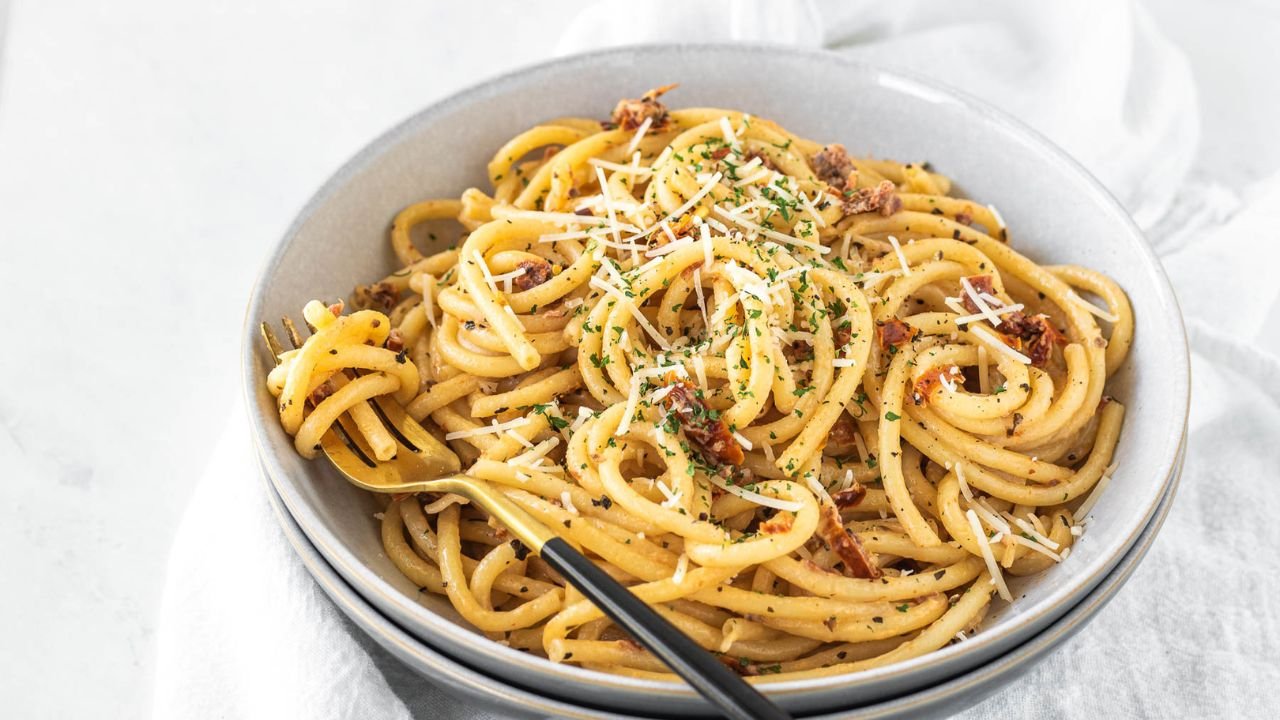Introduction
In the vast world of pasta dishes, certain recipes stand out for their vibrant flavors, fresh ingredients, and ability to elevate simple staples into gourmet experiences. One such dish is Sun-Dried Tomato Dill Linguine, a harmonious blend of tangy sun-dried tomatoes, fragrant fresh dill, and perfectly cooked linguine pasta. Combining Mediterranean flair with a touch of herbal freshness, this dish has become a favorite among home cooks and professional chefs alike.
This comprehensive guide delves into every aspect of Sun-Dried Tomato Dill Linguine—from its origins and ingredient selection to step-by-step preparation, variations, pairing suggestions, and health benefits. Whether you’re seeking a quick weeknight dinner or an impressive dish for a gathering, this pasta recipe offers versatility, flavor, and elegance.
Origins and Cultural Context
While the exact origins of Sun-Dried Tomato Dill Linguine are difficult to pinpoint, it embodies the essence of Mediterranean cuisine, which emphasizes fresh, preserved, and flavorful ingredients. The Mediterranean region, particularly Italy, Greece, and Southern France, has long celebrated pasta dishes infused with herbs, sun-dried fruits, and aromatic oils.
Sun-Dried Tomatoes in Mediterranean Cuisine
Sun-dried tomatoes have been a staple in Mediterranean cooking for centuries. Their concentrated flavor and chewy texture make them an ideal addition to pasta, salads, and antipasti. Traditionally sun-dried in the warm Mediterranean sun, these tomatoes are now often dried through dehydration processes, preserving their rich umami and tangy notes.
Dill’s Role in Mediterranean and Eastern European Cooking
Dill is a fragrant herb widely used in Eastern European, Scandinavian, and Mediterranean cuisines. Its bright, slightly tangy flavor complements seafood, potatoes, and yogurt-based sauces. Incorporating dill into pasta lends a fresh, herbaceous note that balances the richness of sun-dried tomatoes.
Fusion and Modern Interpretations
Today, Sun-Dried Tomato Dill Linguine exemplifies a fusion of Mediterranean flavors with modern culinary creativity. It reflects the trend of combining preserved ingredients with fresh herbs to produce vibrant, healthful dishes. Its versatility makes it suitable for a variety of dietary preferences—from vegetarian to pescatarian.
Essential Ingredients and Their Selection
Creating the perfect Sun-Dried Tomato Dill Linguine begins with selecting quality ingredients. Each component contributes to the dish’s overall flavor, texture, and aroma.
1. Pasta: Linguine
Linguine, a type of long, flat pasta similar to fettuccine but narrower, pairs beautifully with light, flavorful sauces. Its shape holds the sun-dried tomato pieces and herbs well, providing a satisfying bite.
Tips for selection:
- Choose high-quality, durum wheat semolina-based linguine for al dente texture.
- Consider whole wheat or gluten-free options for dietary needs.
- Freshly made or artisanal pasta can elevate the dish.
2. Sun-Dried Tomatoes
The star ingredient, sun-dried tomatoes, offer intense umami and tang. They can be purchased either dry-packed or oil-packed.
Selection tips:
- Opt for high-quality, organic sun-dried tomatoes for better flavor.
- If using dry-packed, rehydrate in warm water or olive oil before chopping.
- Oil-packed sun-dried tomatoes are often more flavorful and convenient.
3. Olive Oil
A good extra-virgin olive oil forms the base of the sauce and adds richness. It also helps to rehydrate and extract flavors from sun-dried tomatoes.
4. Fresh Dill
Fresh dill provides a bright, herbal aroma that balances the richness of the sun-dried tomatoes.
Selection tips:
- Use fresh dill for maximum flavor.
- Discard any wilted or yellowed stems.
- Add dill towards the end of cooking to preserve its delicate flavor.
5. Garlic
Garlic adds depth and aroma. Use fresh garlic cloves, minced finely.
6. Lemon Juice and Zest
A splash of fresh lemon juice and a bit of zest brighten the dish, adding acidity and freshness.
7. Parmesan or Pecorino Romano Cheese
Grated cheese enhances flavor and provides a creamy, salty note.
8. Salt and Pepper
Seasoning is crucial. Use sea salt or kosher salt and freshly ground black pepper.
9. Optional Add-ins
- Crushed red pepper flakes for heat.
- Capers or olives for added briny flavor.
- Seafood (shrimp, scallops) for a pescatarian version.
- Cherry tomatoes for extra freshness.
Step-by-Step Preparation
Achieving the perfect Sun-Dried Tomato Dill Linguine involves careful attention to technique and timing. Below is a detailed step-by-step guide.
1. Preparing the Sun-Dried Tomatoes
Rehydrating (if dry-packed):
- Place the dry sun-dried tomatoes in a bowl.
- Cover with warm water or olive oil.
- Let soak for 15-20 minutes until softened.
- Drain and pat dry.
- Chop finely or julienne.
Using oil-packed:
- Simply drain the oil.
- Chop directly.
2. Cooking the Pasta
- Bring a large pot of salted water to a boil.
- Add linguine and cook until al dente, following package instructions (usually 8-10 minutes).
- Reserve about 1 cup of pasta water before draining.
- Drain and set aside.
3. Making the Sauce
- In a large skillet, heat 2-3 tablespoons of extra-virgin olive oil over medium heat.
- Add minced garlic and cook for 30 seconds until fragrant.
- Add chopped sun-dried tomatoes and cook for another 2-3 minutes to release flavors.
- Optional: add red pepper flakes for a spicy kick.
4. Combining Pasta and Sauce
- Add the cooked linguine to the skillet with the sun-dried tomato mixture.
- Toss to coat evenly.
- If the mixture seems dry, add reserved pasta water gradually until desired consistency is reached.
- Squeeze fresh lemon juice and add lemon zest for brightness.
- Add chopped fresh dill, stirring gently to incorporate.
- Season with salt and pepper to taste.
- Remove from heat.
5. Serving
- Plate the linguine in warmed bowls or plates.
- Garnish with freshly grated Parmesan or Pecorino Romano cheese.
- Add extra dill or lemon zest as desired.
- Serve immediately for best flavor and texture.
Variations and Creative Twists
While the classic Sun-Dried Tomato Dill Linguine is delightful on its own, experimenting with variations can cater to different tastes and dietary preferences.
Vegetarian Version
- Add roasted vegetables like bell peppers, zucchini, or eggplant.
- Incorporate fresh herbs such as basil or parsley.
Seafood Addition
- Sauté shrimp, scallops, or chunks of firm white fish in olive oil before combining with pasta.
- Finish with a squeeze of lemon.
Creamy Variation
- Stir in a splash of heavy cream or Greek yogurt at the end for a richer sauce.
- Use mascarpone or cream cheese for a velvety texture.
Vegan Adaptation
- Omit cheese or substitute with nutritional yeast.
- Use olive oil and lemon to keep the sauce light.
- Add sautéed vegetables or vegan protein sources like tofu.
Spicy Version
- Incorporate red pepper flakes or chopped fresh chili peppers.
Nutty Accent
- Sprinkle toasted pine nuts or chopped walnuts for added crunch and flavor.
Pairing and Serving Suggestions
Complement your Sun-Dried Tomato Dill Linguine with a variety of side dishes and beverages for a complete dining experience.
Wines
- White wines: Sauvignon Blanc, Pinot Grigio, or Vermentino.
- Red wines: Light reds like Pinot Noir or Chianti.
- Rosé: A crisp, dry rosé pairs well with herbal and tomato flavors.
Side Dishes
- Mixed green salad: With vinaigrette and fresh herbs.
- Garlic bread or herbed focaccia: For a comforting carb addition.
- Roasted vegetables: Asparagus, zucchini, or cherry tomatoes.
Desserts
- Light fruit tarts, lemon sorbet, or panna cotta to finish on a refreshing note.
Nutritional Profile and Health Benefits
While indulgent, this dish also offers nutritional benefits:
- Tomatoes: Rich in lycopene, antioxidants, and vitamin C.
- Dill: Contains vitamins A and C, antioxidants, and anti-inflammatory compounds.
- Olive oil: Heart-healthy monounsaturated fats.
- Garlic: Known for immune-boosting and anti-inflammatory properties.
- Herbs: Add flavor with minimal calories.
To make the dish healthier:
- Use whole wheat or gluten-free pasta.
- Limit cheese or opt for lower-fat options.
- Incorporate vegetables for added fiber and nutrients.
Cultural Significance and Modern Trends
This dish exemplifies a broader culinary trend toward combining preserved ingredients with fresh herbs to create flavorful, healthful meals. It reflects a Mediterranean-inspired approach emphasizing simplicity, quality ingredients, and vibrant flavors.
In recent years, there’s been a surge in plant-based and gluten-free pasta options, making dishes like Sun-Dried Tomato Dill Linguine accessible to a wider audience. The dish’s adaptability also aligns with contemporary clean-eating philosophies.
Tips for Perfecting Sun-Dried Tomato Dill Linguine
- Quality ingredients: The flavor hinges on the quality of sun-dried tomatoes and olive oil.
- Timing: Add herbs at the right moment to preserve their aroma.
- Pasta water: Use reserved pasta water to adjust sauce consistency and add flavor.
- Freshness: Incorporate fresh herbs and lemon just before serving for maximum aroma.
- Presentation: Garnish with extra herbs and cheese for visual appeal.
Conclusion
Sun-Dried Tomato Dill Linguine is a celebration of Mediterranean flavors, fresh herbs, and simple yet sophisticated cooking. Its vibrant colors, complex aromas, and balanced taste make it a versatile dish suitable for any occasion—from casual weeknights to elegant dinners.
By understanding its ingredients, techniques, and variations, home cooks can craft personalized versions that reflect their palate and dietary needs. The dish’s healthful profile and adaptability also make it an appealing choice for those seeking nutritious, flavorful meals.
Whether served as a main course or paired with other Mediterranean-inspired dishes, Sun-Dried Tomato Dill Linguine promises a delightful culinary experience that transports the senses to the sunny coasts of the Mediterranean with every bite.

